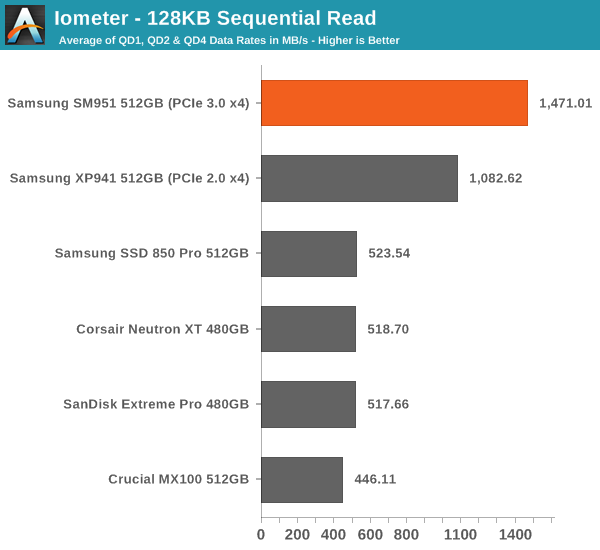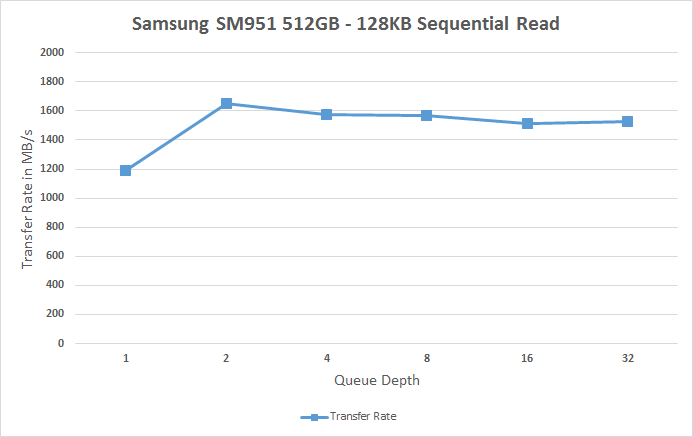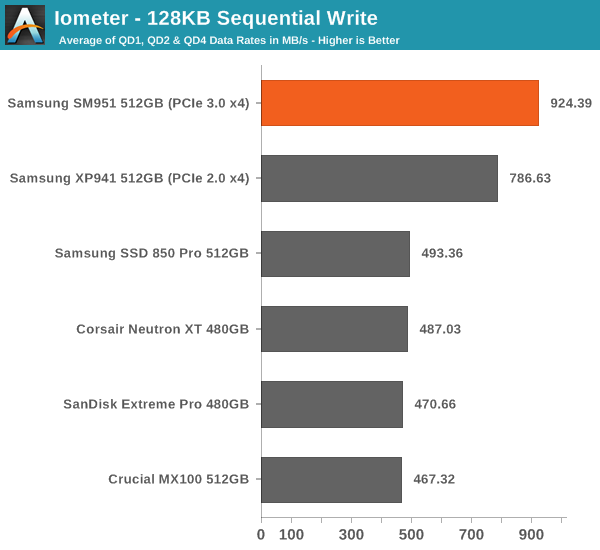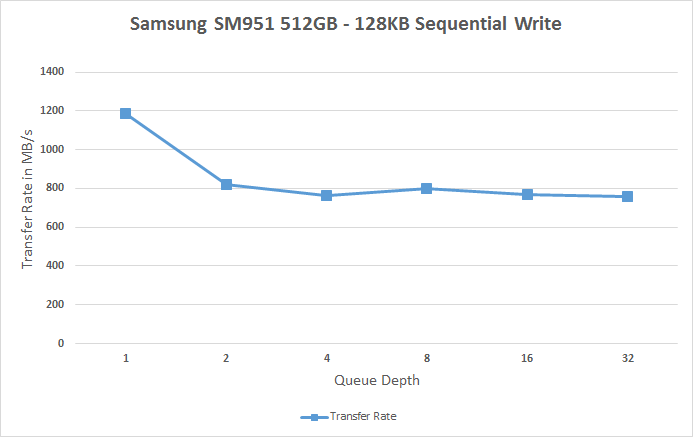Samsung SM951 (512GB) PCIe SSD Review
by Kristian Vättö on February 24, 2015 8:00 AM ESTSequential Read Performance
Our sequential tests are conducted in the same manner as our random IO tests. Each queue depth is tested for three minutes without any idle time in between the tests and the IOs are 4K aligned similar to what you would experience in a typical desktop OS.

The sequential tests really show the benefit of PCIe 3.0 because the SM951 is approximately three times faster than a SATA 6Gbps drive and provides a ~40% upgrade over the XP941.
 |
|||||||||
The line graph does reveal some anomalies, though. First it looks like the performance scales nicely, but after queue depth of two the performance actually degrades. I'm doing some thermal throttling tests later in the article and it's very likely that the read results are affected by that because I was able to reach 2250MB/s at queue depth of 32 with a cold drive (i.e. I went straight to QD32 without doing the scaling first that heats up the drive).
Sequential Write Performance
Sequential write testing differs from random testing in the sense that the LBA span is not limited. That's because sequential IOs don't fragment the drive, so the performance will be at its peak regardless.

Sequential performance is also great, but seems to be affected by thermal throttling even more. That said, I did reach over 1500MB/s with a cold drive.
 |
|||||||||










128 Comments
View All Comments
Kristian Vättö - Tuesday, February 24, 2015 - link
PCIe adapters are fine for review purposes and are in fact more easily serviceable than M.2 slots tend to be.Samus - Tuesday, February 24, 2015 - link
Thank you for pointing out all capacities are M2 2280 DOUBLE SIDED. That is missing from virtually all reviews, sales material and eCommerce sites for M2 drives. Newegg has been pretty good about taking pictures of both sides of many drives, though.This is important to me because I work with HP Elitebook's and the newest generation of the Elitebook 810 (G2) and 820\1040 all require single-sided. The 840 has room for M2 DS modules, though.
Flash13 - Tuesday, February 24, 2015 - link
The company is not trustworthy! Buy at your own risk. Good Luck.youtard - Tuesday, February 24, 2015 - link
hurr!Wardrop - Tuesday, February 24, 2015 - link
Does this form factor work in standard desktop PCI-e 4x slots?DanNeely - Tuesday, February 24, 2015 - link
It's an m-2 plug, you need an adapter to fit it in a standard pcie slot.wtallis - Wednesday, February 25, 2015 - link
When discussing NVMe, please make it clear that the chipset and motherboard firmware only matter for booting off the drive; they don't need any updates to allow a compatible operating system to access the drive as something other than the boot volume.(As for what the motherboard firmware needs to gain in order to allow booting from NVMe devices, it's just a loadable UEFI device driver. Even if your motherboard doesn't have such a driver built-in, you could load it from some other storage device and then boot off the NVMe drive.)
ericgl21 - Wednesday, February 25, 2015 - link
I wonder if Samsung (or any other OEM) would be willing to sell a 1TB m.2 NVMe PCIe3.0 x4 SSD with SLC NAND with a 2280 form factor?Many professionals would appreciate the speed and reliability that SLC NAND provides.
Sure, it would cost a lot, but so do the Samsung SM951 and Intel P3700.
If that's not possible with current 16nm manufacturing, then a 512GB would also be nice. :-)
Just my 2 cents.
baii9 - Wednesday, February 25, 2015 - link
reliable on nand? Reliable controller matters, high endurance nand matters, I think nand are "reliable' enough already(compare to that lovely controller).IlikeSSD - Wednesday, February 25, 2015 - link
looks like Samsung paid for not showing OCZ in consistency and mixed workload tests )))))